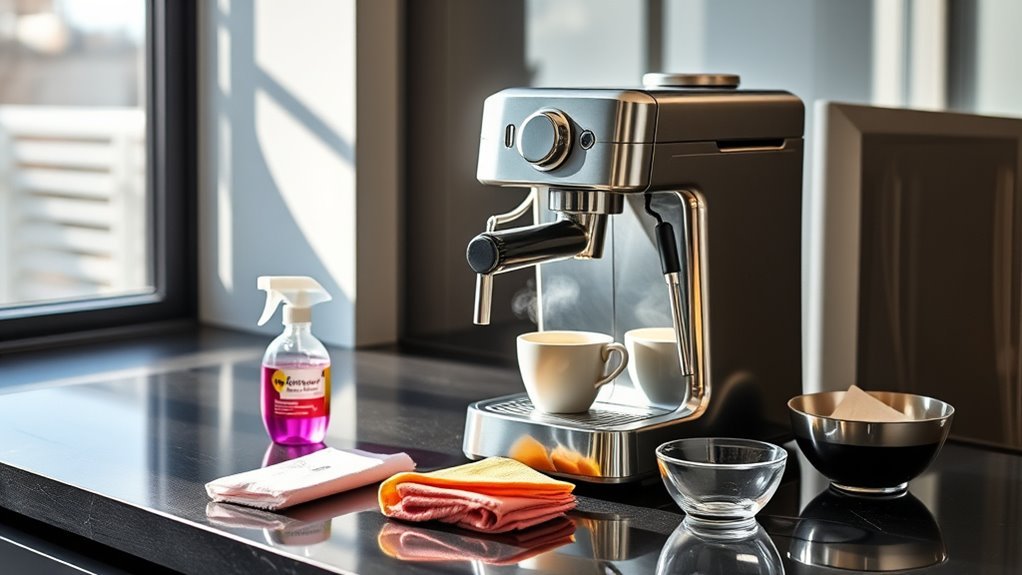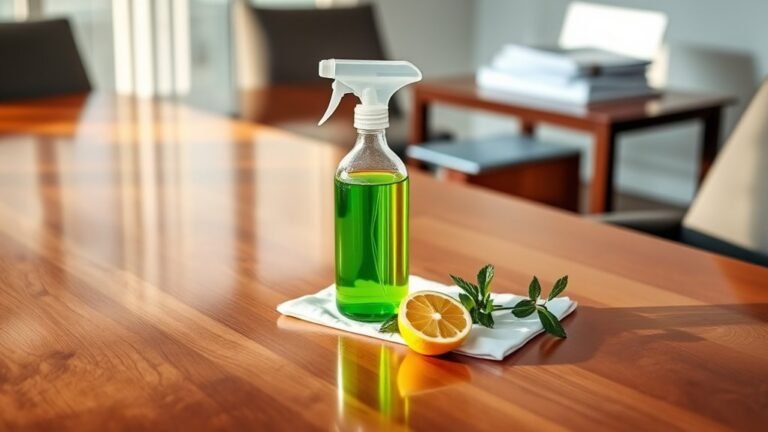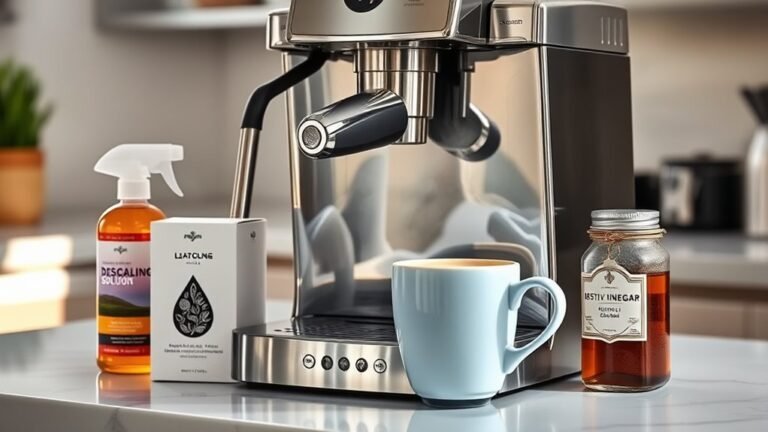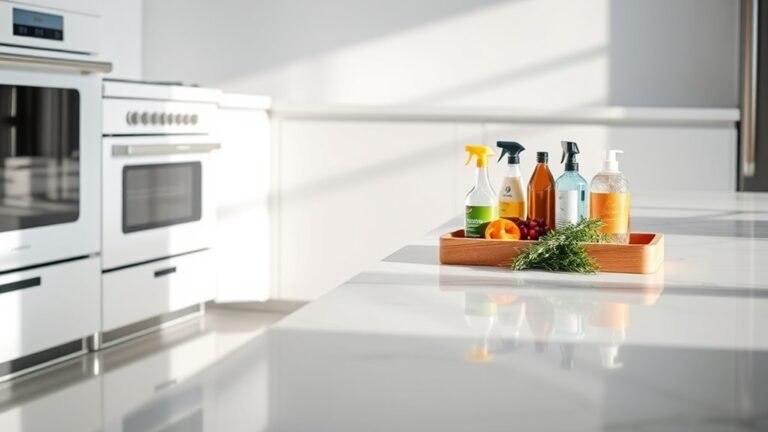How to Clean Coffee Machine in Office Spaces
To clean your office coffee machine, wipe down all exterior surfaces daily and empty the drip tray to prevent buildup. Weekly, remove and wash detachable parts with warm, soapy water, and descale using a recommended solution to clear mineral deposits that affect taste and function. Sanitize water reservoirs and contact surfaces regularly to reduce germs. Using proper cleaners designed for coffee machines protects your equipment and coffee quality. Keep maintaining these habits, and you’ll guarantee a consistently great brew and hygienic workspace.
Understanding Different Types of Office Coffee Machines

There are three main types of office coffee machines you’ll commonly encounter: drip coffee makers, single-serve pod machines, and espresso machines. Drip brewers are straightforward, brewing several cups at once—ideal when you need freedom from constant refills. Single-serve pod machines prioritize convenience and speed, allowing you to grab a quick cup without measuring grounds. Espresso machines, on the other hand, deliver a rich, concentrated coffee experience but often require more attention and care. Knowing these types helps you choose the right machine for your office’s pace and preferences. Each demands a tailored cleaning approach to keep performance at its best and prevent buildup that can affect taste. Understanding your machine is the first step toward maintaining freedom from coffee downtime and ensuring every cup tastes fresh.
Daily Cleaning Routine for Office Coffee Machines
You should start your daily cleaning by wiping down all exterior surfaces to remove spills and dust. Next, clean the brew basket thoroughly to prevent old coffee buildup. Don’t forget to empty and rinse the drip tray to keep your machine running smoothly and hygienic. Promptly addressing spills and residues helps prevent persistent discoloration and ensures a clean coffee machine.
Wiping Exterior Surfaces
Wiping down the exterior surfaces of your office coffee machine every day keeps it looking clean and prevents buildup of dust, coffee oils, and fingerprints. Regular exterior cleaning is essential for both aesthetics and hygiene. For effective surface sanitization, follow these steps:
- Unplug the machine to guarantee safety before you start.
- Use a soft, damp microfiber cloth with a mild detergent to wipe all visible surfaces.
- Pay special attention to buttons, handles, and display panels where oils and germs accumulate.
- Finish by wiping with a clean, dry cloth to avoid streaks and maintain a polished look.
Consistent exterior cleaning not only extends your machine’s life but also promotes a healthier office environment, giving you freedom from sticky residues and grime.
Cleaning Brew Basket
Although cleaning the brew basket might seem like a small task, it’s critical for maintaining the flavor quality and hygiene of your office coffee machine. Start by removing the basket immediately after brewing to prevent coffee grounds from drying and clogging it. Use warm water and a mild detergent to scrub away oils and residue—this is one of the most effective cleaning techniques. Rinse thoroughly to avoid leftover soap affecting taste. For daily maintenance, check for buildup and clean the basket at least once a day. Incorporate these maintenance tips into your routine to keep your machine running smoothly and your coffee tasting fresh. Regular attention to the brew basket not only guarantees better flavor but also extends the machine’s lifespan, giving you freedom from frequent repairs.
Emptying Drip Tray
Emptying the drip tray daily is essential to prevent overflow and maintain cleanliness around your office coffee machine. Proper drip tray maintenance supports office hygiene and keeps your workspace inviting. Here’s how to handle it efficiently:
- Slide out the drip tray carefully to avoid spilling any collected liquid.
- Dispose of the contents into a sink or drain promptly.
- Rinse the tray with warm, soapy water to remove coffee residue and bacteria.
- Dry the tray thoroughly before placing it back to prevent mold growth.
Weekly Deep Cleaning Procedures
A thorough weekly deep cleaning is crucial to keep your office coffee machine running smoothly and producing great-tasting coffee. Stick to a weekly checklist that includes removing and washing all detachable parts—such as the filter basket, water reservoir, and drip tray—with warm, soapy water. Wipe down the exterior surfaces to remove coffee stains and oils that build up over time. Follow your cleaning schedule strictly to prevent residue buildup, which can affect flavor and machine performance. Don’t forget to clean the brew head and any accessible internal components using a soft brush or cloth. Maintaining this routine not only extends your machine’s lifespan but also guarantees every cup tastes fresh, giving you the freedom to focus on what matters without worrying about coffee quality or machine issues. Adjust your cleaning frequency based on water hardness and the machine’s usage to ensure optimal descaling and maintenance.
Descaling Your Coffee Machine to Remove Mineral Deposits

Since mineral deposits can build up inside your coffee machine over time, descaling is essential to maintain its efficiency and guarantee the best coffee flavor. Mineral buildup restricts water flow and affects heating, so regular descaling prevents damage and preserves taste. Here’s how to tackle it effectively:
Descaling removes mineral buildup, ensuring your coffee machine runs efficiently and your coffee tastes its best.
- Choose a suitable descaling solution recommended for your machine.
- Fill the water reservoir with the descaling solution diluted as instructed.
- Run a full brewing cycle without coffee grounds, allowing the solution to clean internal parts.
- Rinse the machine thoroughly by running multiple cycles with fresh water.
Cleaning Removable Parts and Accessories
Cleaning removable parts and accessories regularly is essential to keep your coffee machine functioning smoothly and hygienically. Start by detaching all removable parts like the filter basket, portafilter, and frothing wand. Use warm soapy water and a soft brush to scrub away coffee oils and residue. Rinse thoroughly and allow them to air dry completely before reassembling. Avoid harsh chemicals that may damage the materials. For safety, always ensure the machine is unplugged before removing parts to prevent accidents related to high-touch areas.
| Removable Part | Cleaning Method | Frequency |
|---|---|---|
| Filter Basket | Soak & scrub with brush | After each use |
| Portafilter | Warm soapy water | Daily |
| Frothing Wand | Wipe & flush with water | After each use |
Sanitizing the Water Reservoir and Drip Tray

You’ll want to tackle mineral deposits in the water reservoir regularly to keep your machine running smoothly. Use a suitable descaling solution to break down buildup without damaging components. Then, disinfect both the reservoir and drip tray thoroughly to prevent bacteria and maintain hygiene. Regular cleaning with approved disinfectants helps ensure effective performance and prevents microbial growth.
Removing Mineral Deposits
Mineral deposits can build up quickly in your coffee machine’s water reservoir and drip tray, affecting both taste and performance. Tackling mineral buildup is essential to keep your machine running smoothly and your coffee tasting fresh. Here’s how to remove these deposits effectively:
- Empty the water reservoir and drip tray completely.
- Apply a commercial descaling solution or a vinegar-water mix to the reservoir.
- Let it sit for 15-30 minutes to break down mineral buildup.
- Thoroughly rinse both the reservoir and drip tray with clean water to remove any residue.
Regularly removing mineral deposits prevents clogs and extends your machine’s lifespan, giving you more freedom to enjoy great coffee without interruptions.
Disinfecting Surfaces Properly
Two key areas that need regular disinfecting in your coffee machine are the water reservoir and drip tray. These spots often harbor bacteria and mold if neglected. Start by emptying and rinsing both components thoroughly. Use effective surface sanitizers designed for food-contact surfaces to avoid harmful residues. Apply the disinfecting techniques recommended by the sanitizer’s instructions—usually letting the solution sit for several minutes guarantees proper germ elimination. After disinfecting, rinse everything well with clean water to remove any chemical traces. Dry the parts completely before reassembling. Following this routine not only keeps your coffee fresh but also protects everyone using the machine. Staying consistent with these steps gives you the freedom to enjoy clean, safe coffee without unnecessary hassle or risk.
Dealing With Coffee Oils and Stains
Although coffee oils may seem harmless, they quickly build up and cause stubborn stains that affect both taste and machine performance. To keep your office coffee machine running smoothly, tackle these oils and stains regularly with proven stain removal steps. Here’s what you should do:
Coffee oils build up fast, causing stains that harm taste and machine performance—regular cleaning is essential.
- Disassemble removable parts and soak them in warm, soapy water to break down coffee oils.
- Use a soft brush to scrub away any lingering residues without damaging surfaces.
- Wipe the machine’s exterior and drip tray with a damp cloth to remove visible stains.
- Run a cycle with just water to flush out remaining oils inside the machine.
- Use a microfiber cloth when wiping the exterior to prevent streaks and maintain the machine’s shine.
Best Cleaning Products for Office Coffee Machines
Choosing the right cleaning products is essential to maintaining your office coffee machine’s performance and longevity. Opt for commercial cleaning supplies designed specifically for coffee machines—they guarantee effective removal of coffee oils, mineral deposits, and stains without damaging components. Prioritize eco-friendly cleaners to reduce chemical exposure and environmental impact, especially in shared office spaces. These green products work just as efficiently, keeping your machine safe and your workspace healthier. Avoid harsh abrasives or generic household cleaners, which can corrode internal parts. Stick to recommended descalers and cleaning tablets that tackle buildup while preserving your machine’s integrity. By selecting appropriate, eco-friendly commercial cleaning supplies, you safeguard your coffee maker’s function and extend its service life, freeing you from frequent repairs and unscheduled downtime. Regular maintenance also helps prevent mineral deposits, which can impair machine efficiency and flavor quality.
Tips for Maintaining Coffee Machine Hygiene in Busy Offices
To keep your office coffee machine hygienic, stick to a daily cleaning routine that removes coffee residue and prevents buildup. Regular descaling is essential to avoid mineral deposits that affect taste and machine performance. Don’t forget to sanitize touchpoints like buttons and handles to reduce germ spread in busy environments.
Daily Cleaning Routine
Keeping your office coffee machine clean every day is essential to promote great-tasting coffee and prevent buildup that can affect performance. Sticking to a daily cleaning routine guarantees consistent quality and extends your machine’s lifespan. The right cleaning frequency delivers clear benefits: fewer breakdowns, better flavor, and a healthier workspace.
Follow these simple steps daily:
- Wipe down the exterior and drip tray to remove spills and stains.
- Rinse and clean the removable parts like the filter basket and water reservoir.
- Run a water-only brew cycle to flush out any residual coffee oils.
- Empty used grounds and clean the brew basket thoroughly.
Descaling Importance
Why should you prioritize descaling your office coffee machine regularly? Because mineral buildup from hard water gradually clogs internal components, reducing performance and coffee quality. Maintaining a strict descaling frequency—typically every 1 to 3 months depending on usage and water hardness—prevents costly repairs and downtime. Using appropriate descaling solutions guarantees safe, effective removal of scale without damaging your machine. Neglecting this essential step leads to slower brewing, off-flavors, and shortened equipment lifespan. To keep your office running smoothly and your coffee tasting fresh, integrate descaling into your maintenance routine. Don’t wait for problems; proactive descaling protects your investment and supports a hygienic, efficient coffee experience that keeps everyone free to focus on their work.
Sanitizing Touchpoints
Regular descaling keeps your coffee machine running smoothly, but it’s just one part of maintaining a clean office coffee station. You need to focus on sanitizing touchpoints, which are the most frequently handled parts. These surfaces, often made from stainless steel, plastic, or rubber, can harbor germs if neglected. Use effective sanitizing methods tailored to these touchpoint materials to guarantee safety and hygiene.
Here’s what you should do:
- Identify all touchpoints: buttons, levers, handles, drip trays.
- Use disinfectant wipes or sprays compatible with touchpoint materials.
- Wipe down these areas daily, especially during high-traffic hours.
- Train staff on proper sanitizing techniques to maintain consistency.
This routine helps prevent contamination and keeps your office coffee station inviting and germ-free.
Troubleshooting Common Coffee Machine Cleaning Issues
How do you handle it when your coffee machine won’t clean properly despite following the usual steps? Start with coffee machine troubleshooting by identifying common cleaning issues like scale buildup, clogged nozzles, or residue in the water reservoir. If your machine still looks dirty, try running a descaling cycle with a specialized solution—never use harsh chemicals. Check filters and detachable parts for blockages and clean them separately. Sometimes, incomplete cleaning happens because water temperature isn’t high enough to dissolve oils; verify your machine reaches the proper heat. If problems persist, consult the manufacturer’s guide to avoid voiding warranties. By addressing these common cleaning issues head-on, you maintain your freedom from frequent breakdowns and keep your office coffee tasting fresh and reliable.
Frequently Asked Questions
How Often Should Office Coffee Machines Be Replaced?
You should consider office coffee machine replacement based on coffee machine longevity and replacement criteria like frequent breakdowns, outdated features, or inconsistent brew quality. Typically, machines last 3-5 years with proper care, but if maintenance costs rise or it hampers productivity, it’s time to upgrade. Don’t wait too long—choosing the right moment guarantees your team enjoys great coffee without interruptions, giving you freedom from constant repairs and downtime.
Can Office Coffee Machine Cleaning Affect Coffee Taste?
Back in the age of telegrams, you’d never imagine a grimy coffee machine could sabotage your brew. But it does. Regular cleaning frequency directly influences taste improvement; neglect allows old oils and residues to build up, dulling flavor and aroma. By keeping your machine spotless, you’ll reveal a fresher, bolder cup every time. So, if you want coffee that fuels your freedom and focus, don’t skip cleaning—it’s key to better taste.
Are There Eco-Friendly Cleaning Alternatives for Office Coffee Machines?
You can definitely use eco-friendly cleaning alternatives like a vinegar solution and baking soda for your coffee machine. Mix equal parts water and white vinegar for descaling, then use baking soda to tackle stubborn stains or odors. These natural ingredients are effective, non-toxic, and cheap, giving you a clean machine without harsh chemicals. This way, you’re keeping your office coffee fresh and the environment happy, all while maintaining your freedom from pricey commercial cleaners.
What Are the Health Risks of Not Cleaning Office Coffee Machines?
If you don’t keep your coffee machine clean, bacteria growth can become a serious problem, putting everyone’s health at risk. Ignoring hygiene standards invites mold and germs, leading to potential stomach issues or infections. You want your office environment to be safe and comfortable, so maintaining cleanliness isn’t just about looks—it’s about protecting your team’s well-being and freedom from preventable illnesses. Regular cleaning is essential and non-negotiable.
How to Train Staff on Proper Coffee Machine Cleaning Procedures?
You’ll want to start by creating a clear cleaning checklist that outlines daily, weekly, and monthly tasks. Then, organize staff workshops to demonstrate proper techniques and emphasize hygiene importance. Encourage questions and hands-on practice to build confidence. Make sure everyone knows their role and the cleaning schedule, so it becomes routine rather than a chore. This way, your team stays empowered, ensuring the coffee machine stays spotless and safe without constant oversight.






